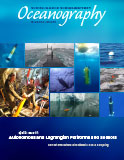Article Abstract
The tropical Atlantic basin is one of seven global regions where tropical cyclones (TCs) commonly originate, intensify, and affect highly populated coastal areas. Under appropriate atmospheric conditions, TC intensification can be linked to upper-ocean properties. Errors in Atlantic TC intensification forecasts have not been significantly reduced during the last 25 years. The combined use of in situ and satellite observations, particularly of temperature and salinity ahead of TCs, has the potential to improve the representation of the ocean, more accurately initialize hurricane intensity forecast models, and identify areas where TCs may intensify. However, a sustained in situ ocean observing system in the tropical North Atlantic Ocean and Caribbean Sea dedicated to measuring subsurface temperature, salinity, and density fields in support of TC intensity studies and forecasts has yet to be designed and implemented. Autonomous and Lagrangian platforms and sensors offer cost-effective opportunities to accomplish this objective. Here, we highlight recent efforts to use autonomous platforms and sensors, including surface drifters, profiling floats, underwater gliders, and dropsondes, to better understand air-sea processes during high-wind events, particularly those geared toward improving hurricane intensity forecasts. Real-time data availability is key for assimilation into numerical weather forecast models.

